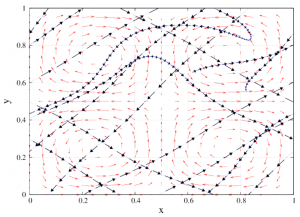Differential and absolute negative mobility in steady laminar flows
 Nonlinear response in out-of-equilibrium systems can show counter-intuitive behaviors, for instance cases where the force increases but the response decreases (negative differential mobility). Sometimes the response crosses zero and changes sign with respect to the force (absolute negative mobility). In classical physics this is usually observed within complicate models with obstacles and traps. We have demonstrated such complex non-linear phenomena in a much simpler and realistic system, ie.… Read the rest
Nonlinear response in out-of-equilibrium systems can show counter-intuitive behaviors, for instance cases where the force increases but the response decreases (negative differential mobility). Sometimes the response crosses zero and changes sign with respect to the force (absolute negative mobility). In classical physics this is usually observed within complicate models with obstacles and traps. We have demonstrated such complex non-linear phenomena in a much simpler and realistic system, ie.… Read the rest

